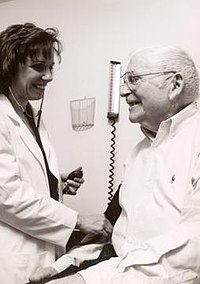
Photo from wikipedia
The education of health professionals in primary care has expanded substantially during the three decades since I first qualified as a family medicine doctor, or general practitioner (GP), as members… Click to show full abstract
The education of health professionals in primary care has expanded substantially during the three decades since I first qualified as a family medicine doctor, or general practitioner (GP), as members of my clinical discipline are more commonly known in the UK. I can recall visiting GPs in their place of work in South London when I was an undergraduate medical student, having been given very little guidance on what I was meant to learn before I attended, and simply being sat in a corner as a passive observer of healthcare when I arrived. I did not see any other students from either my own or any other health profession, nor did I see any qualified doctors in training to become GPs. However, at that time, the very fact that I was given any clinical placement in a community medicine setting represented progress as medical education moved slowly away from the Flexnerian1 concept of a preclinical bioscience phase of education followed by an apprenticeship phase of clinical learning conducted entirely within the walls of teaching hospitals towards more integrated, learner-centred curricula with the inclusion of community healthcare experience. This shift was beautifully encapsulated by Harden and colleagues’ Spices Model,2 which challenged curriculum designers to decide where on a set of spectra they wished their curriculum to lie. But what has happened since? Well, the number of doctors training to become GPs, though still not at the level needed in the UK, has increased. The number of doctors graduating from UK medical schools has also increased from 4432 in the year 2000 to 8730 in 2021,3 and the proportion of time spent in primary care by medical students has increased “from <1.0% of clinical teaching in 1968 to 13.0% by 2008; (though) since then, the percentage has plateaued”.4 Furthermore, other healthcare professions such as pharmacy, nursing and physician associates are now also spending some of their time in training in primary care. So, what is it about primary care that makes it such a good place to learn about healthcare? There are very many features of education in primary care that could be offered in response to this question, and I can only cover some of them in this article, but my answer starts by quoting the eminent Australian GP and medical educationalist, Richard Hays, who observed that in primary care...
Journal Title: International journal of medical education
Year Published: 2021
Link to full text (if available)
Share on Social Media: Sign Up to like & get
recommendations!